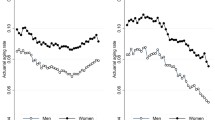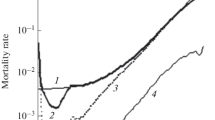Abstract—Using data gathered from 40 countries throughout a historical period covering two and a half centuries, we studied the peculiarities of age-related changes in the aging rate for the countries in the world and elucidated the possibilities and limitations of the method for quantitatively measuring the aging effect according to parameters related to the analysis of population mortality. Mortality rate and its derivatives are variables of the Gompertz formula: m(t) =\({{R}_{0}}\exp (kt)\), where m is the mortality rate at time t (age), R0 is the initial mortality level, and k is the rate of mortality increase; both components are believed to be associated with aging, and of the Gompertz–Makeham formula (with an additional coefficient A as the constant mortality rate, which depends on external conditions). The A and R0 components are not necessarily uniform for different ages and affect each other, changing controversially, as well as the R0 and k components. To characterize the external effects on mortality, it is better to use the R0 of the Gomperеtz formula; when the values of external effects on mortality are high, the k component of the Gomperеtz formula can be used to evaluate aging. At the same time, when the A coefficient is low, it is better to use the k component of the Gompertz–Makeham formula. In this case, absolute comparison of the components of the Gompertz and Gompertz–Makeham formulas is not reasonable because these components may differ considerably. The mortality increment d(m) is the best indicator to reflect the biological nature of aging and the changes of the latter for an exact age. However, it may reflect certain particular changes in total mortality for certain ages. Using this indicator, it can be observed that the main patterns of the aging process have persisted throughout all historical periods and for all countries. The mortality curves for early periods of history are discontinuous and distorted due to the faults of the methods for collecting primary data and not because of actual events. Hence, it is necessary to remember that the components of the formulas may have biological meaning only when mathematical proof is supported by biological methods and data.







Similar content being viewed by others
REFERENCES
T. M. Smirnova and V. N. Krut’ko, Klin. Gerontol. 24 (9–10), 63 (2018).
V. Canudas-Romo, S. Mazzuco, and L. Zanotto, in Handbook of Statistics, Vol. 39, Part A: Integrated Population Biology and Modeling, Ed. by A. S. S. Rao and C. Rao (Elsevier, Amsterdam, 2018), pp. 405–442.
B. Gompertz, Phil. Trans. Roy. Soc. Lond. A 115, 513 (1825).
X. Dong, B. Milholland, and J. Vijg, Nature 538 (7624), 257 (2016).
A. Lenart and J. W. Vaupel, Nature 546 (7660), E13 (2107).
J. De Beer, A. Bardoutsos, and F. Janssen, Nature 546 (7670), E16 (2017).
E. Barbi, F. Lagona, M. Marsili, et al., Science 362 (6412), pii: eaav3229 (2018).
The Human Mortality Database. http://www.mortality.org. Cited January 25, 2019.
L. A. Gavrilov and N. S. Gavrilova, The Biology of Life Span: A Quantitative Approach (Harwood Acad. Publ., New York, 1991).
V. I. Dontsov, Zdravookhr. Ross. Fed. 63 (1), 42 (2019).
S. Dato, G. Rose, P. Crocco, et al., Mech. Ageing Dev. 165 (Pt. B), 147 (2017).
L. Hayflick, PLoS Genet. 3 (12), 220 (2007).
A. I. Ribeiro, E. T. Krainski, M. S. Carvalho, et al., Geospat. Health 12 (2), 581 (2017).
C. E. Finch, Proc. Natl. Acad. Sci. U. S. A. 107 (1), 1718 (2010).
A. A. Grinevich, A. V. Tankanag, and N. K. Chemeris, Biophysics (Moscow) 64 (1), 117 (2019).
V. N. Krut’ko, V. I. Dontsov, V. A. Khalyavkin, et al., Front. Biosci. (Landmark Ed.) 23, 909 (2018).
V. B. Mamaev, Biophysics (Moscow) 63 (5), 831 (2018).
N. L. Vekshin and M. S. Frolova, Biophysics (Moscow) 64 (1), 137 (2019).
Author information
Authors and Affiliations
Corresponding author
Ethics declarations
The authors declare that they have no conflict of interest. This work does not describe any studies using humans and animals as objects.
Additional information
Translated by I. Shipounova
Rights and permissions
About this article
Cite this article
Krut’ko, V.N., Dontsov, V.I. Mortality as an Indicator of Aging: Possibilities and Limitations. BIOPHYSICS 65, 165–171 (2020). https://doi.org/10.1134/S0006350920010108
Received:
Revised:
Accepted:
Published:
Issue Date:
DOI: https://doi.org/10.1134/S0006350920010108




